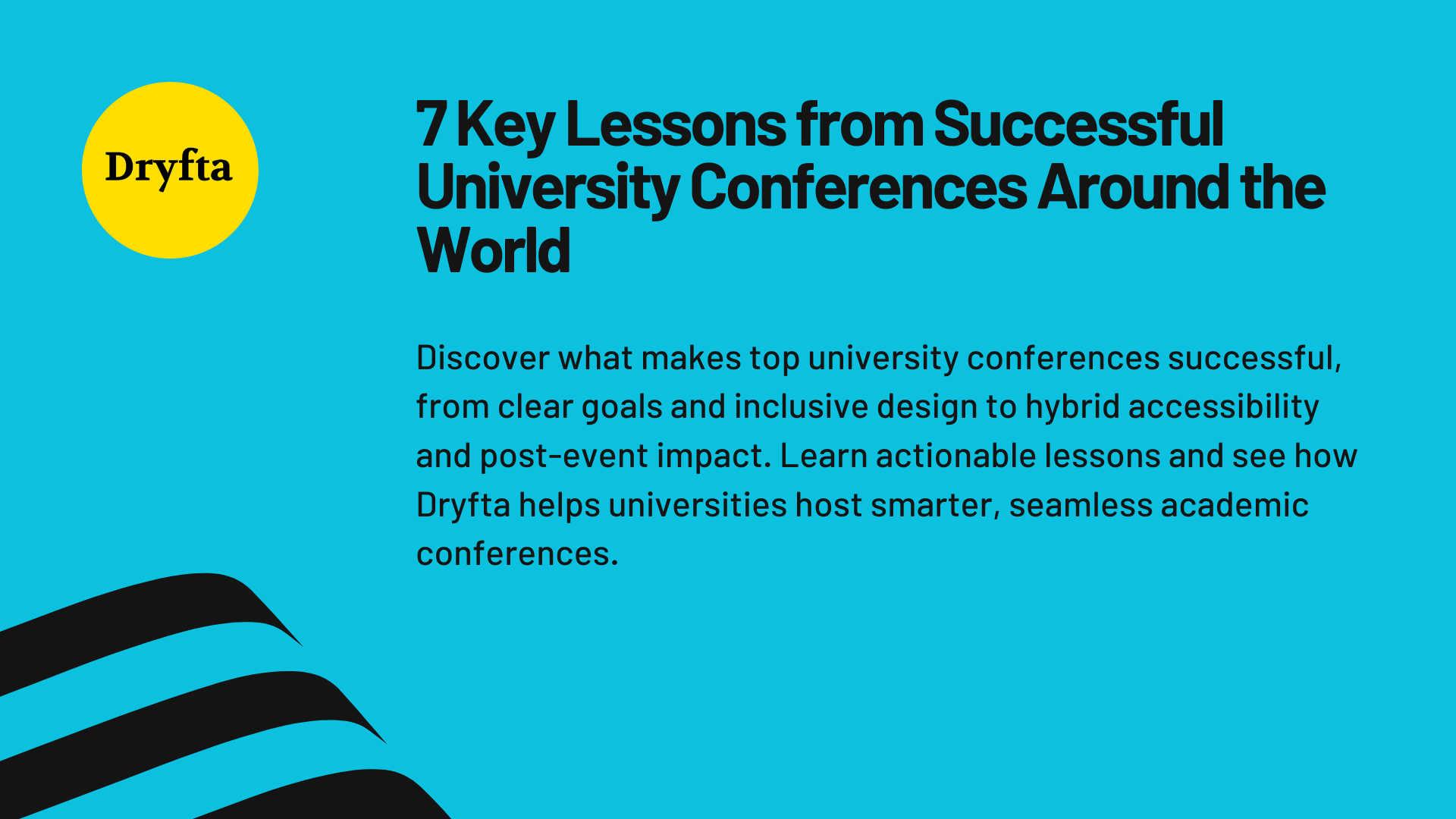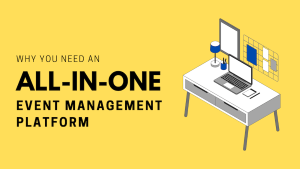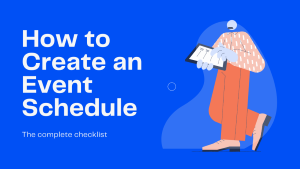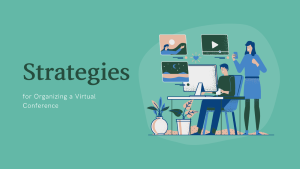
Running a successful and well-organized university conference is more than just booking a lecture hall and inviting speakers. The last ten years, to a large extent, the pandemic, have been the period of transformation for the university conferences that have become dynamic hybrid spaces now combining learning, networking, and digital access.
These are seven main lessons from the best university conferences worldwide, and under each of them, you can find the real-world examples and the practical takeaways that you can employ for your next event.
1. Clear Conference Purpose from the Start
The academic conferences at the top universities always have a clear purpose it is to share new research, train the future scholars, and bring together experts from different fields to collaborate. Stating your goals clearly from the start shapes the Call for Papers (CFP), session design, review criteria, and event promotion.
Actual instance: The Ethnography in Education Research Forum, University of Pennsylvania, used the annual meeting of its conference as a platform for creating a supportive venue for scholars at different career stages. An inclusive exchange of scholarly research was the one goal that made all the elements of the conference – the CFP, panels, and mentoring sessions – unite.
Takeaway: Have concrete conference outcomes drafted on the very first day, and then use them as a checklist for every decision related to the planning.
2. Easier Abstract and Peer-review Process
The quality of any program relies heavily on a transparent and efficient system for abstract submission and peer review. A slow and complicated review system will thus act as a deterrent to contributors and, as a result, the probability of obtaining excellent papers will be quite low.
Actual instance: Several universities, such as Johns Hopkins, Erasmus, and the AMS Institute, Amsterdam, that were employing Dryfta have reported that the procedure of abstract collection, reviewer assignment, and academic conference website building services was going very smoothly, which in turn was helping them to scale up to thousands of submissions without causing any chaos. In 2021, the Memory Studies Association hosted an entirely online conference that had 230 panels and nearly 1,500 participants without a single platform failure.
Takeaway: Selecting a platform that easily allows blind review, reviewer assignment, conflict of interest checks, and automated scheduling seems like a straightforward right choice. Also, note that providing reviewers with timelines and scoring rubrics can enhance the sense of fairness .
3. Design Equally for In-person and Online Audiences
Both in-person and virtual conference participants need to be treated fairly. Therefore, the overall session timing, interaction option, and moderator role need to consider the physical gap and be able to provide participants with the ability to ask questions, take part in live polls, and access the sessions post-event on demand.
Actual instance: Research shows that facilitators who asked remote participants what they wanted, like networking, access to videos, or Q&A sessions, better understood their needs and could solve their problems more easily. The University of Oxford has highlighted the need to choose the right platform for virtual conferences. They also stress the importance of providing clear information for hybrid events.
Takeaway: The takeaway is to draft your session scripts with prompts for virtual participants, prepare the moderator for virtual participants, and provide shorter presentation content for virtual attendees.
4. Maintain Content Diversity to Keep People Engaged
It’s very important to provide different types of content if you are to keep your participants engaged. Changing conference formats gives you the chance to offer different ways of learning at the conference.
Roundtables, workshops, poster sessions, and facilitated networking are formats that can include brief and short talks. Different formats will attract participants with different learning styles, and will also give them more opportunities for collaborative learning.
Actual instance: At the SBCC Summit, Johns Hopkins has offered a multi-track, hybrid model with more than 260 hybrid sessions and thousands of abstracts. Such a variety of programs fulfilled the different needs of the audiences, developing audience goals, technical skill building, policy debate, and practitioner networking, all happening simultaneously.
Takeaway: When planning an agenda, aim for a mix of 40-50% research presentations, 20% workshops, 20% policy sessions, and 10-20% networking activities. This balance will create consistency across the conference sessions.
5. Prioritize Accessibility and Inclusivity from the Outset
Accessible academic conferences are those that go beyond just facilitating physical access and providing captions to ensure that all attendees can participate equally in every aspect of the event. In addition to that, it is necessary to think about the possible obstacles. These obstacles may appear when it comes to time zones, recordings, repeated sessions, language for translated abstracts, or multilingual panels.
Actual instance: Major virtual conferences have demonstrated that the removal of travel and accommodation barriers has significantly increased participation, especially from low-resource regions. Platforms that enabled captioning and asynchronous access helped users from different time zones remain engaged.
Takeaway: Enable tiered pricing, offer travel or registration grants to early-career or low-income researchers, and allocate your platform budget for captioning and recordings.
6. Purposefully Invest in Community and Networking
Networking through matchmaking tools and group discussions is essential, as it allows you to meet new people, find mentors, and connect with like-minded individuals.
Actual instance: Conferences that implemented platform features for curated meetups and topic lounges, or organized mentorship breakfasts, experienced more follow-up collaboration and better feedback from early-career participants. Dryfta case studies from universities highlight features like customizable badges, attendee matchmaking, and targeted email campaigns, which were the factors that led to improved engagement.
Takeaway: Incorporate a networking schedule into the program and advertise it before the event; provide attendees with clear reasons and times for meeting.
7. Measure Impact and Follow Up, Conferences Are a Process, Not a Single Day
Conferences that conclude and are never thought of again have little effectiveness. Take immediate feedback, keep track of metrics (attendance, session drop-off, repeat visitors), and plan post-conference outputs: recordings, proceedings, community forums, or collaborative publications.
Actual instance: When AILA 2021, the World Congress of Applied Linguistics, went live, over 2,400 participants were registered. The event included more than 260 themed sessions, allowing attendees to engage in discussions through audio, video, or chat. All sessions were recorded and made available for viewing at any time until the following year.
Takeaway: Within 4 weeks, share a brief post-conference report with speakers and funders that should include attendance numbers, top sessions, and next steps for the community.
Follow-up Checklist:
-
- Write down and make your conference results public, and the criteria for acceptance on the CFP page.
- Make reviewer workflows an automated process, and also, communicate the deadlines clearly.
- Prepare only one session to have remote participants inherently (moderator + Q&A).
- Create a mentorship or “first-time attendee” onboarding session.
- Put away 10-15% of your budget for recording or captioning and technical support.
- Arrange another webinar as a follow-up, 6 to 8 weeks after the conference, to keep up the energy.
Parting Thoughts
Academic conferences are the main source of knowledge and community; however, the effectiveness of these conferences is highly dependent on the design choices that are made. One should begin with the results, ensure that participation is equitable and accessible, create for hybrid audiences, and evaluate the long game.
In case you are organizing a conference and need assistance in turning any of these insights into a feasible plan, Dryfta’s case studies demonstrate how universities have achieved it on a large scale. Make your conference enjoyable! Schedule a demo with Dryfta to see how easy it is to manage and promote your event.




